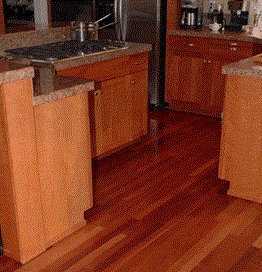
Engineered wood flooring can seem heaven sent for homeowner’s who want nothing more than to install hardwood flooring in high moisture areas such as kitchens, bathrooms, and basements. It isn’t that stone flooring isn’t nice or attractive, but some simply find it too cold for their tastes. Vinyl flooring is certainly an option, and is even available in wood grained patterns, but it’s just not the same as real wood. Engineered wood flooring provides homeowners with a kind of middle ground between solid hardwoods and some alternative imitation.
What is Engineered Wood Flooring? Engineered wood flooring is made up of an inner core of hardwood and/or softwood plywood or HDF and a top layer of real hardwood that is glued on the surface of the core. These cores usually incorporate the tongue and groove system for easier installation. These layers are formed in a cross-grain pattern and bonded together under heat and pressure. As a result, engineered wood flooring is less likely to be affected by changes in humidity.
Engineered Wood Flooring and Moisture Engineered wood flooring is slightly more resistant to higher moisture levels than solid wood flooring. The inner core is able to expand and contract naturally without causing damage to the floor, unlike solid wood that tends to warp in high humidity conditions. That’s why engineered hardwood flooring can be installed on any grade level whether the installation site is above, below or at ground level. This moisture-resistance feature also allows the engineered wood floor to be used for basement floors.
Engineered wood floors are manufactured in two ways, a ‘sliced’ cut where the hardwood wear layer shows an original look of the wood and finer graining. The other is a ‘rotary’ cut, which shows a dramatic wider graining. The cut you choose will depend largely on the look you wish to create in your home.
Options for Engineered Wood Flooring Engineered wood flooring is usually an easy do-it-yourself installation material. It comes in a wide variety of styles, sizes, and species. Some brands have a thin wear layer that can only be recoated and cannot be sanded and refinished after the use. Refinishable engineered wood flooring has a very thick wear layer and can be sanded and refinished up to 4 – 5 times if they wear out. Engineered floors can be nailed, stapled, or glued down. They may also be floated over a wide variety of subfloors, including some types of existing flooring, with the click together method. Choosing Engineered Wood Flooring Engineered wood flooring isn’t limited only to high moisture areas of the home. It is one of the rare flooring materials that truly can be installed practically anywhere. They are particularly well suited to climates that are humid by nature such as tropical areas, but that doesn’t mean low humidity climates can’t enjoy all of the benefits that come with this material as well. As well as they perform in humidity, just think of how resilient they can be under optimal circumstances!
Ultimately, your choice in flooring materials is exactly that: your choice. However, if you really want hardwood flooring in your home and have been told it is impossible because of the humidity, engineered wood flooring can give you the look you desire with the flexibility that high humidity environments require.





